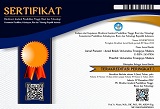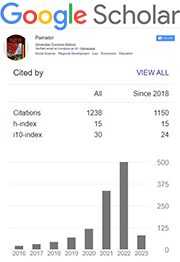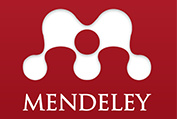Comparative Analysis of the Success of the Islamic Economy A Historical Study of the Economic Reforms of Abdul Malik bin Marwan and Umar Bin Abdul Aziz
Abstract
Keywords
Full Text:
PDFReferences
Alya, Zetrina, and Sebastian Herman, ‘How Omar Bin Abdul Aziz Reached Economic Golden Era: Unearthing the Umayyad History From Economics Perspective’, Islamic Economics and Business Review, 2.2 (2023)
Amin, Nur Fadilah, Sabaruddin Garancang, and Kamaluddin Abunawas, ‘Konsep Umum Populasi Dan Sampel Dalam Penelitian’, Jurnal Pilar, 14.1 (2023), 15–31
Aravik, Havis, and Ahmad Tohir, ‘Perekonomian Pada Masa Dinasti Umayyah Di Andalusia; Sejarah Dan Pemikiran’, ADL ISLAMIC ECONOMIC: Jurnal Kajian Ekonomi Islam, 1.1 (2020), 81–98
Basri, Muhammad, Dinda Salsabila, and Faisa Rahma Safira Siregar, ‘Masa Kemajuan Islam (650-1000 Masehi)’, Madani: Jurnal Ilmiah Multidisiplin, 1.12 (2024)
Halima, Raden Ayu, Muh Nur Rochim Maksum, and Hakimuddin Salim, ‘Check for Updates The Impact of Al-Murabbithun Movement Arrival on Islamic Education in Al-Andalus’, in Proceedings of the International Conference on Islamic and Muhammadiyah Studies (ICIMS 2023) (Springer Nature, 2023), DCCLXXIII, 332
Hariyanti, Emi, and Kholid Mawardi, ‘Perkembangan Ekonomi Dan Administrasi Pemerintahan Masa Dinasti Umayyah’, Journal on Education, 6.1 (2023), 1762–73
Hasibuan, Sri Wahyuni, Hasbi Ash Shiddieqy, Al Haq Kamal, Rusny Istiqomah Sujono, Andi Triyawan, Mohammad Zen Nasrudin Fajri, and others, ‘Sejarah Pemikiran Ekonomi Islam’, 2021
Hidayatulloh, Muhammad Haris, Muhtadi Ridwan, and Khusnuddin Khusnuddin, ‘Konsep Pemikiran Ekonomi Islam Era Bani Umayah Dan Relevansi Dengan Masa Sekarang’, Al-Kharaj: Jurnal Ekonomi, Keuangan & Bisnis Syariah, 6.1 (2024), 348–59
Hoyland, Robert, Muslims and Others in Early Islamic Society (Routledge, 2021)
Huda, Muhammad Nurul, ‘Sejarah Pemikiran Ekonomi Islam Pada Masa Daulah Bani Umayyah Dan Bani Abbasiyah’, Estoria: Journal of Social Science and Humanities, 1.2 (2021), 135–48
Kalkavan, Hakan, Hasan Dinçer, and Serhat Yüksel, ‘Analysis of Islamic Moral Principles for Sustainable Economic Development in Developing Society’, International Journal of Islamic and Middle Eastern Finance and Management, 14.5 (2021), 982–99
Karnaini, Zul, ‘Concept and Application of Good Governance in Umar Bin Abdul Aziz’s Reign’, PETITA, 6 (2021), 111
Khairunnisa, Fadillah, and Zakiah Nurul Fadhilah, ‘Kebijakan Ekonomi Pada Masa Kegemilangan Islam Umar Bin Abdul Aziz’, Journal Of Islamic Management Applied, 1.1 (2021), 1–7
Kirani, Ratu, Nova Wildan Firmansyah, and Erina Helda Mariyah, ‘Pemikiran Ekonomi Islam Pada Masa Bani Umayyah’, JEBESH: Journal of Economics Business Ethic and Science Histories, 1.1 (2023), 115–22
Larum, Kordianus, Diana Zuhroh, and Edi Subiyantoro, ‘Fraudlent Financial Reporting: Menguji Potensi Kecurangan Pelaporan Keuangan Dengan Menggunakan Teori Fraud Hexagon’, AFRE Accounting and Financial Review, 4.1 (2021), 82–94
Meirison, Meirison, and Desmadi Saharuddin, ‘The Distinction of Government Administration and Judicial Institutions in The Umayyad Dynasty’, Buletin Al-Turas, 27.1 (2021), 123–38
Muflihin, Muhammad Dliyaul, ‘Perekonomian Di Masa Dinasti Umayyah: Sebuah Kajian Moneter Dan Fiskal’, Indonesian Interdisciplinary Journal of Sharia Economics (IIJSE), 3.1 (2020), 58–69
Qoyum, Abdul, Sejarah Pemikiran Ekonomi Islam (Jakarta: Departemen Ekonomi dan Keuangan Syariah - Bank Indonesia, 2021)
Rachman, Yoga Tantular, ‘Analysis Of Land And Building Tax According To Islamic Economic Perspective’, Review of Islamic Economics and Finance, 6.1 (2023), 23–38
Rahman, Agussalim, ‘Poverty Alleviation Strategies and Patterns In the Era of Caliph Umar Bin Abdul Aziz Government’, International Journal of Management, 12.2 (2021)
Rofiqo, Azidni, and Fitra Rizal, ‘Kebijakan Ekonomi Pada Masa Kekhalifahan Bani Umayyah (Studi Kasus Keberhasilan Kebijakan Khalifah Umar Bin Abdul Aziz Dan Kegagalan Gubernur Nasar Bin Sayyar Pada Masa Khalifah Marwan II 744–750 Masehi)’, Al-Tsaqafa: Jurnal Ilmiah Peradaban Islam, 16.2 (2019), 226–36
Saprida, M H I, Sejarah Pemikiran Ekonomi Islam (Prenada Media, 2021)
Tahir, Ibrahim Nuhu, ‘Poverty Alleviation Strategies Implemented by’Umar Ibn’Abd Al Aziz: Lessons for Muslim Economists on Achieving SDG of Poverty Alleviation’, International Journal of Economics, Management and Accounting, 28.2 (2020), 483–515
Ulhaq, Muhammad Zia, ‘Pengelolaan Keuangan Publik Islam (Umar Bin Abdul Aziz)’, Amal: Jurnal Ekonomi Syariah, 2.01 (2020)
DOI: https://doi.org/10.21107/pamator.v17i2.25912
Refbacks
- There are currently no refbacks.
Copyright (c) 2024 Muhammad Hafiz Ikhsan, Imsar Imsar, Muhammad Syahbudi

This work is licensed under a Creative Commons Attribution-ShareAlike 4.0 International License.
Jurnal Pamator : Jurnal Ilmiah Universitas Trunojoyo by Universitas Trunojoyo Madura is licensed under a Creative Commons Attribution-ShareAlike 4.0 International License.















.png)